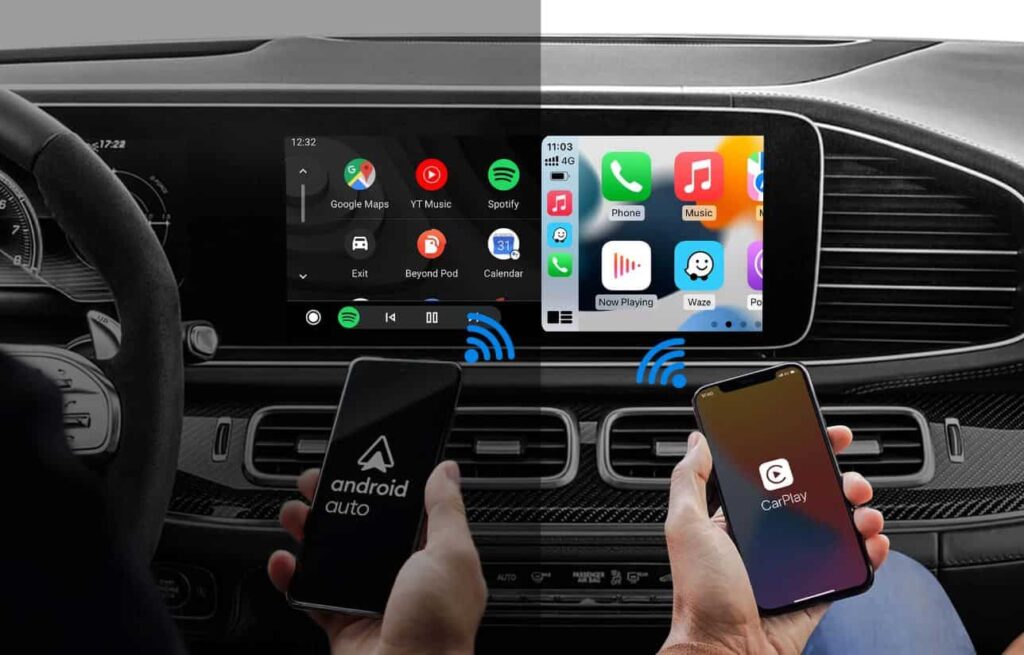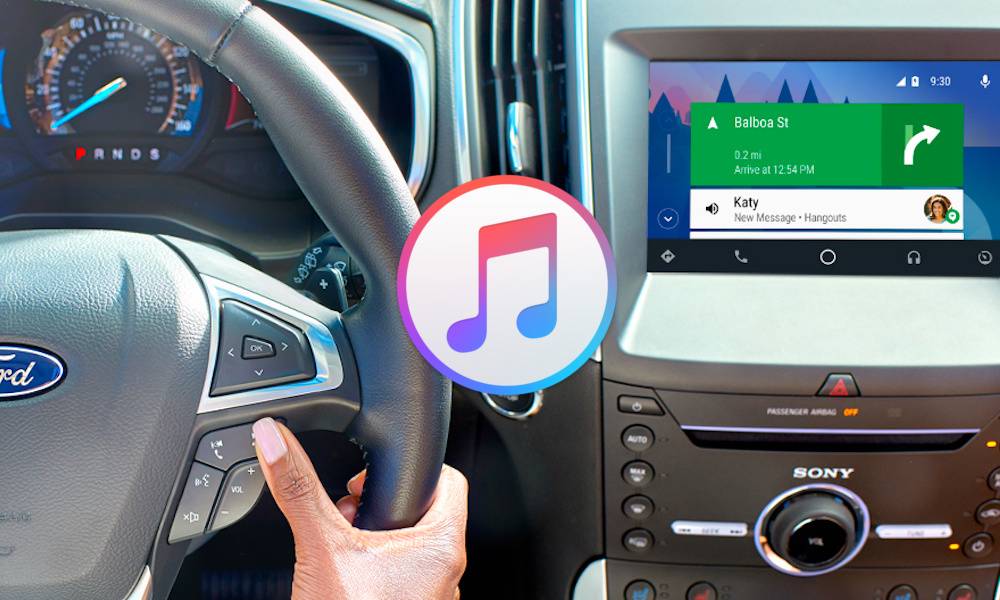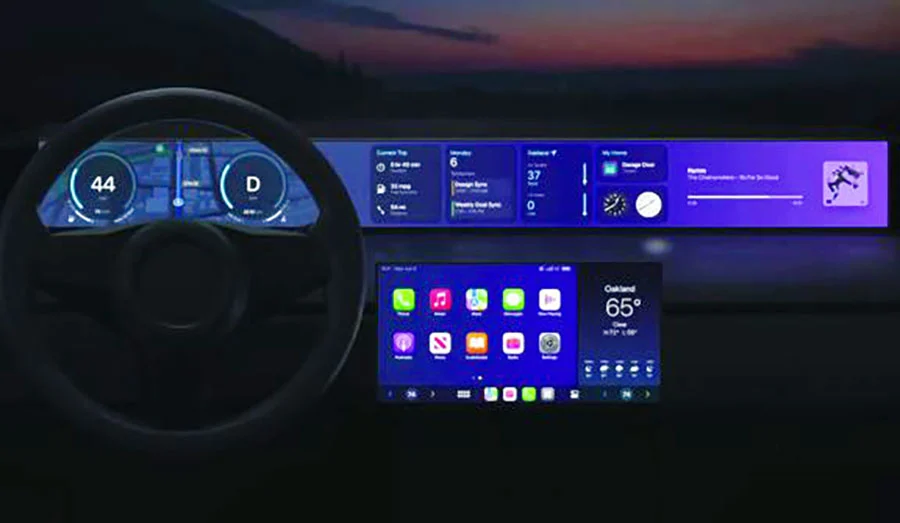INTRO…….
In the rapidly evolving landscape of automotive technology, two standout innovations have revolutionised the way we interact with our vehicles: Apple CarPlay and Android Auto. These systems seamlessly integrate smartphones with car infotainment systems, offering a plethora of features aimed at enhancing convenience, safety, and entertainment. In this comprehensive guide, we’ll take a deep dive into the functionalities, types, setup process, and practical uses of both Apple CarPlay and Android Auto.

Introduction to Apple CarPlay and Android Auto
Understanding Apple CarPlay
Apple CarPlay, an ingenious creation by Apple Inc., serves as a bridge between your iPhone and your car’s dashboard. It’s designed to mirror select iPhone features onto the vehicle’s display, allowing users to access maps, make calls, send messages, and listen to music hands-free.
Deciphering Android Auto
Android Auto, crafted by Google, is the Android counterpart to Apple CarPlay. It offers a similar suite of features for Android smartphone users, seamlessly integrating apps and functionalities with the car’s infotainment system. Android Auto harnesses the power of Google Assistant for voice-controlled navigation, communication, and entertainment.
Types of Apple CarPlay and Android Auto Systems
Built-In Systems: Seamlessness Redefined
Some vehicles come equipped with built-in support for Apple CarPlay and Android Auto. These integrated systems offer a user-friendly interface and a wide array of features, providing the ultimate seamless experience for drivers. While they offer unparalleled integration, they may require purchasing a compatible vehicle.
Aftermarket Systems: Flexibility Unleashed
For vehicles lacking built-in support, aftermarket solutions come to the rescue. These solutions, including head units, multimedia receivers, and adapters, can be retrofitted into existing vehicles, adding smartphone integration capabilities. Aftermarket systems offer flexibility and compatibility across a wide range of vehicles, albeit with the need for professional installation.
Wireless Connectivity: Cutting the Cord
Initially reliant on wired USB connections, newer models of Apple CarPlay and Android Auto support wireless connectivity. This revolutionary feature eliminates the need for physical cables, offering greater convenience and reducing clutter within the vehicle’s cabin.

How to Use Apple CarPlay and Android Auto
Setting Up Apple CarPlay: A Step-by-Step Guide
To embark on your journey with Apple CarPlay, follow these steps:
- Check Compatibility: Ensure your iPhone and vehicle support CarPlay.
- Connect Your iPhone: Use a Lightning cable to establish a connection between your iPhone and the car’s USB port.
- Enable CarPlay: Navigate to the CarPlay settings on your vehicle’s infotainment system and follow the prompts to activate CarPlay.
- Navigate with Siri: Utilize Siri voice commands or the touchscreen interface to access maps, make calls, and engage with other features seamlessly.
Setting Up Android Auto: A Comprehensive Walkthrough
Unlock the full potential of Android Auto with these simple steps:
- Verify Compatibility: Confirm that both your Android smartphone and vehicle support Android Auto.
- Download the App: Retrieve the Android Auto app from the Google Play Store onto your smartphone.
- Establish Connection: Utilize a USB cable to connect your smartphone to the car’s USB port.
- Activate Android Auto: Access the Android Auto settings on your vehicle’s infotainment system and follow the prompts to enable Android Auto.
- Navigate with Google Assistant: Harness the power of Google Assistant to effortlessly navigate, communicate, and access entertainment features using voice commands or the touchscreen.
Practical Uses of Apple CarPlay and Android Auto
Navigation and Maps: Your Guiding Companion
Leverage Apple CarPlay and Android Auto to embark on seamless journeys with advanced navigation features. Both systems offer access to mapping apps such as Apple Maps, Google Maps, and Waze, providing real-time traffic updates, turn-by-turn directions, and points of interest along the way.
Communication: Stay Connected, Stay Safe
Keep communication at your fingertips while on the road with Apple CarPlay and Android Auto. Effortlessly make calls, send and receive messages, and even have messages read aloud to you, all through intuitive voice commands or touchscreen controls.
Music and Entertainment: Elevate Your Driving Experience
Transform mundane drives into enjoyable experiences with a plethora of entertainment options. Stream your favorite tunes, podcasts, and audiobooks from leading platforms such as Apple Music, Spotify, Pandora, and Google Play Music, all while maintaining focus on the road ahead.

Voice Assistance: Your Personal Co-Pilot
Experience the convenience of hands-free operation with built-in voice assistants. Siri for Apple CarPlay and Google Assistant for Android Auto offer unparalleled functionality, allowing you to perform a myriad of tasks—from setting reminders to controlling smart home devices—with simple voice commands.
Learning the Future of Connected Driving
In conclusion, Apple CarPlay and Android Auto stand as pillars of innovation in the automotive industry, ushering in an era of connected driving experiences. By understanding their functionalities, setup processes, and practical uses, drivers can harness the full potential of these systems to stay informed, entertained, and connected while on the road.
